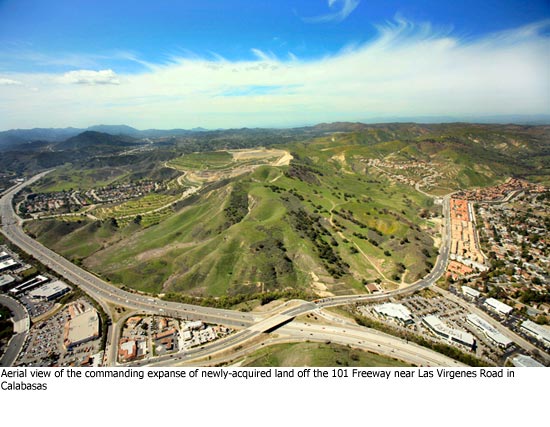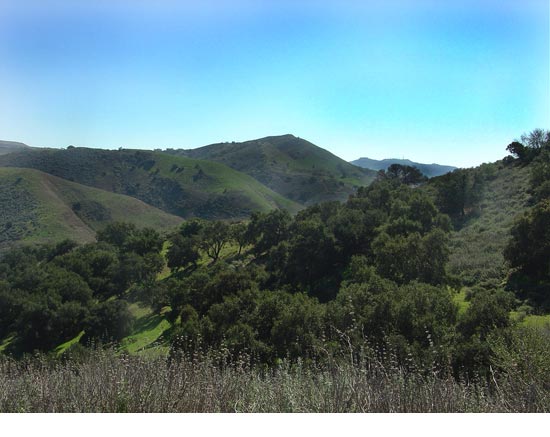Magnificent milestone in the mountains
June 9, 2010
Chalk up another win for the green team. After years of fending off development that could have overwhelmed its oak-studded slopes with condos, shopping centers or a massive megaplex, a spectacular swath of the Santa Monica Mountains can finally rest easy.
It’s now public land—to be preserved for posterity in its natural state.
The $6.25 million acquisition caps more than a decade of efforts by a coalition of government officials, environmentalists and activists seeking to preserve the nearly 200-acre property as an important wildlife corridor and plant habitat.
But the significance of the land—a rustic spread that once belonged to entertainment legend Bob Hope—goes well beyond its environmental value.
It also serves as an unofficial gateway to the Santa Monica Mountains National Recreation Area, visible to the 184,000 motorists who pass each day on the 101 Freeway as a symbol of the wilderness that still exists at the city’s edge.
“It’s just so special,” said Los Angeles real estate legend Fred Sands, who recently agreed to sell the property to the Mountains Recreation and Conservation Authority. “I’ve walked that property and I’ve hiked it. I’ve taken people there and their jaws dropped.”
Sands, who now is involved with commercial real estate ventures involving shopping centers and malls and also has a private equity firm, said he had considered building a horse ranch for his daughter on the property. He also mulled building a shopping center or keeping the land in a family trust and eventually constructing houses there.
He said the time he’d spent on the property changed his mind. “It’s the right thing to do,” he said. “The more I thought about it, the more I thought it shouldn’t be developed. This is just too beautiful.”
He said he’d considered hanging onto the property because it was worth more than he was being paid. But, he said, “I’m not exactly penniless. Not everything has to be about money…There’s a tax advantage. But I don’t need it for the tax advantages.”
“It’s about doing something for the public, and for the future.”
It is ironic but also fitting that the purchase of that scenic expanse is being bankrolled by, well, garbage. Specifically, the land was purchased, in part, with fees charged to hauling companies that use the Calabasas Landfill, along with money from a “gas-to-energy” program there.
 Now that it belongs to the Mountains Recreation and Conservation Authority—a partnership among the Santa Monica Mountains Conservancy, the Conejo Recreation and Park District and the Rancho Simi Recreation and Park District—the agency will maintain the rustic site and open it up to the public starting Saturday, when the property is set to be dedicated.
Now that it belongs to the Mountains Recreation and Conservation Authority—a partnership among the Santa Monica Mountains Conservancy, the Conejo Recreation and Park District and the Rancho Simi Recreation and Park District—the agency will maintain the rustic site and open it up to the public starting Saturday, when the property is set to be dedicated.
Dash Stolarz, a spokeswoman for the MRCA, said that crews were busily clearing brush from a ranch road that runs through the property. Parking is—and will remain—on a dirt lot. “We’re not going to develop it in any way,” she said.
Melanie Beck, an outdoor recreation planner for the National Parks Service, whose land borders the property, said the property will form an important link in the Las Virgenes Creek Trail, which is part of a larger loop called the Calabasas Cold Creek Trail. “I think it’s one of the most important acquisitions that the agencies have taken on in the last few years,” Beck said, noting the “visual relief” it provides for motorists leaving the San Fernando Valley.
Sands bought the property after the previous owner, Robert Zuckerman, was thwarted in his plans to build condominiums and a massive retail center on the land, complete with a 3,600-seat movie theater complex. Zuckerman’s proposal drew the ire of environmentalists and Supervisor Zev Yaroslavsky, and eventually fell apart after the county rejected his building plans.
Yaroslavsky said that Zuckerman had taken him on a tour of the property when he was seeking approval to build. “That was the biggest mistake he could have made,” Yaroslavsky said. “My first look at the dozens of mature oak trees and the pristine nature of the property convinced me on the spot that the property should be part of the Santa Monica Mountains park system.”
He said that after Sands bought the property, he inquired whether Yaroslavsky’s office would support any zoning changes to allow development on the land beyond the small number of homes that would have been permitted under current zoning. The answer was no.
Several years ago, Yaroslavsky approached Sands about selling the property to the MRCA. The agreement came together in the last 60 days.
The property is known to some as Firehouse Hill, a nod to the nearby Los Angeles County Fire Station 125. Others call it “Continental Communities”—a reference to Zuckerman’s ill-fated development plans.
Whatever you call it, the property ranks as the most significant acquisition since the former King Gillette Ranch, which the MRCA opened to the public in 2007. Since Yaroslavsky took office in 1994, almost 23,000 acres in the Santa Monica Mountains have been acquired and set aside as open space.
“We’ve saved a lot of big pieces, but it’s like pieces of a mosaic,” said Dave Brown, a community activist who’s been prominent in the efforts to preserve open space in the mountains. “You have to make sure there won’t be people coming in with inappropriate development plans.”
On the newly-acquired Calabasas property, that’s no longer an issue—to the relief of those, like Brown, who have worried about what might end up on this piece of land that exerts such a strong pull on those who’ve seen it.
“I’ve discovered over many years of living here that many people are emotionally attached to this property,” said Brown, who also is an appointee to the advisory committee of the Santa Monica Mountains Conservancy. “It tells people that they’re in a new area—an unspoiled natural area.”
Watch our video, “Santa Monica Mountains: An Island of Nature,” and read Zev’s blog about the remarkable strides that have taken place to preserve open space in the mountains.
Posted 6/9/2010














 405 bridge work causes a stink
405 bridge work causes a stink
